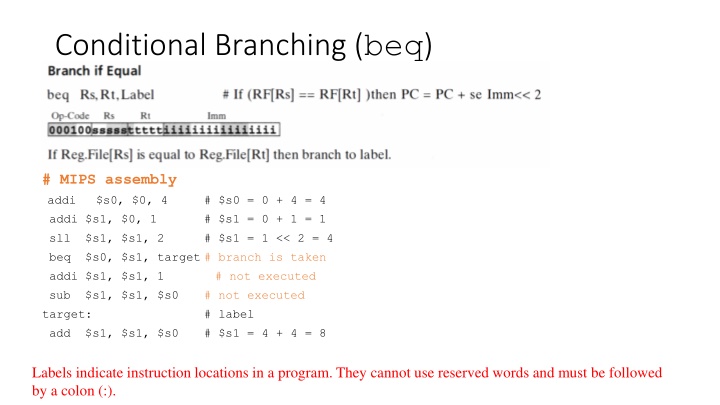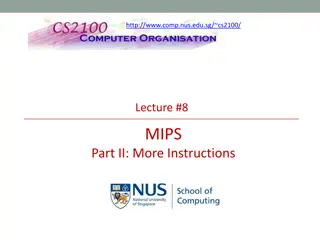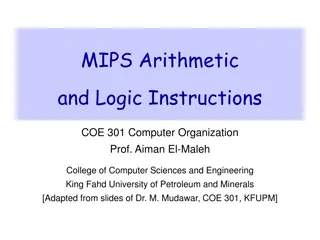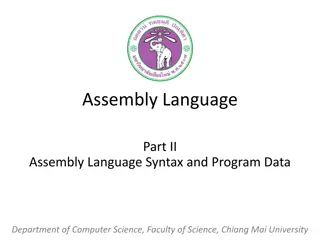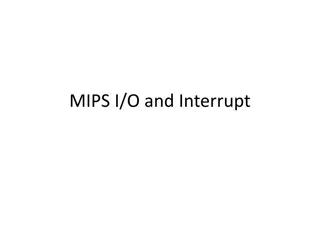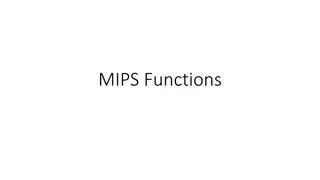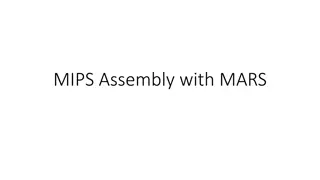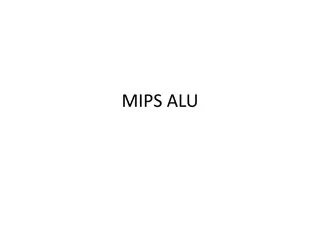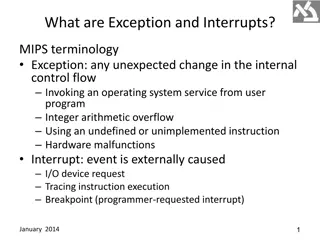MIPS Assembly Programming Guide
This guide covers conditional and unconditional branching in MIPS assembly language, including the beq, bne, j, and jr instructions. It provides examples and explanations for each branching type, along with high-level code constructs such as if/else statements and loops.
Download Presentation

Please find below an Image/Link to download the presentation.
The content on the website is provided AS IS for your information and personal use only. It may not be sold, licensed, or shared on other websites without obtaining consent from the author.If you encounter any issues during the download, it is possible that the publisher has removed the file from their server.
You are allowed to download the files provided on this website for personal or commercial use, subject to the condition that they are used lawfully. All files are the property of their respective owners.
The content on the website is provided AS IS for your information and personal use only. It may not be sold, licensed, or shared on other websites without obtaining consent from the author.
E N D
Presentation Transcript
Conditional Branching (beq) # MIPS assembly addi $s0, $0, 4 # $s0 = 0 + 4 = 4 addi $s1, $0, 1 sll $s1, $s1, 2 beq $s0, $s1, target # branch is taken addi $s1, $s1, 1 # not executed sub $s1, $s1, $s0 # not executed target: add $s1, $s1, $s0 # $s1 = 4 + 4 = 8 # $s1 = 0 + 1 = 1 # $s1 = 1 << 2 = 4 # label Labels indicate instruction locations in a program. They cannot use reserved words and must be followed by a colon (:).
The Branch Not Taken (bne) # MIPS assembly addi $s0, $0, 4 # $s0 = 0 + 4 = 4 addi $s1, $0, 1 # $s1 = 0 + 1 = 1 sll $s1, $s1, 2 # $s1 = 1 << 2 = 4 bne $s0, $s1, target # branch not taken addi $s1, $s1, 1 # $s1 = 4 + 1 = 5 sub $s1, $s1, $s0 # $s1 = 5 4 = 1 target: add $s1, $s1, $s0 # $s1 = 1 + 4 = 5
Unconditional Branching / Jumping (j) # MIPS assembly addi $s0, $0, 4 # $s0 = 4 addi $s1, $0, 1 # $s1 = 1 j target # jump to target sra $s1, $s1, 2 # not executed addi $s1, $s1, 1 # not executed sub $s1, $s1, $s0 # not executed target: add $s1, $s1, $s0 # $s1 = 1 + 4 = 5
Unconditional Branching (jr) # MIPS assembly 0x00002000 addi $s0, $0, 0x2010 0x00002004 jr $s0 0x00002008 addi $s1, $0, 1 0x0000200C sra $s1, $s1, 2 0x00002010 lw $s3, 44($s1) #jump to address that is stored in $s0
High-Level Code Constructs if statements if/else statements while loops for loops
If Statement High-level code MIPS assembly code # $s0 = f, $s1 = g, $s2 = h # $s3 = i, $s4 = j if (i == j) f = g + h; f = f i;
If Statement High-level code MIPS assembly code # $s0 = f, $s1 = g, $s2 = h # $s3 = i, $s4 = j bne $s3, $s4, L1 add $s0, $s1, $s2 if (i == j) f = g + h; f = f i; L1: sub $s0, $s0, $s3 Notice that the assembly tests for the opposite case (i != j) than the test in the high-level code (i == j).
If / Else Statement High-level code MIPS assembly code # $s0 = f, $s1 = g, $s2 = h # $s3 = i, $s4 = j if (i == j) f = g + h; else f = f i;
If / Else Statement High-level code MIPS assembly code # $s0 = f, $s1 = g, $s2 = h # $s3 = i, $s4 = j bne $s3, $s4, L1 add $s0, $s1, $s2 j done L1: sub $s0, $s0, $s3 done: if (i == j) f = g + h; else f = f i;
While Loops High-level code // determines the power // of x such that 2x= 128 int pow = 1; int x = 0; MIPS assembly code # $s0 = pow, $s1 = x addi $s0, $0, 1 add $s1, $0, $0 addi $t0, $0, 128 while: beq $s0, $t0, done sll $s0, $s0, 1 addi $s1, $s1, 1 j while done: while (pow != 128) { pow = pow * 2; x = x + 1; } Notice that the assembly tests for the opposite case (pow == 128) than the test in the high-level code (pow != 128).
For Loops The general form of a for loop is: for (initialization; condition; loop operation) loop body initialization: executes before the loop begins condition: is tested at the beginning of each iteration loop operation: executes at the end of each iteration loop body: executes each time the condition is met
For Loops High-level code // add the numbers from 0 to 9 int sum = 0; int i; MIPS assembly code # $s0 = i, $s1 = sum addi $s1, $0, 0 add $s0, $0, $0 addi $t0, $0, 10 for: beq $s0, $t0, done add $s1, $s1, $s0 addi $s0, $s0, 1 j for done: for (i=0; i!=10; i = i+1) { sum = sum + i; } Notice that the assembly tests for the opposite case (i == 128) than the test in the high-level code (i != 10).
Less Than Comparisons High-level code // add the powers of 2 from 1 // to 100 int sum = 0; int i; MIPS assembly code # $s0 = i, $s1 = sum addi $s1, $0, 0 addi $s0, $0, 1 addi $t0, $0, 101 loop: slt beq add $s1, $s1, $s0 sll $s0, $s0, 1 j loop done: $t1, $s0, $t0 $t1, $0, done #$t1 = 1 if i < 101. for (i=1; i < 101; i = i*2) { sum = sum + i; }
Arrays Useful for accessing large amounts of similar data Array element: accessed by index Array size: number of elements in the array
Arrays 5-element array Base address = 0x12348000 (address of the first array element, array[0]) First step in accessing an array: load base address into a register 0x12340010 array[4] array[3] array[2] array[1] array[0] 0x1234800C 0x12348008 0x12348004 0x12348000
Arrays // high-level code int array[5]; array[0] = array[0] * 2; array[1] = array[1] * 2; # MIPS assembly code # array base address = $s0 lui $s0, 0x1234 ori $s0, $s0, 0x8000 # put 0x1234 in upper half of $S0 # put 0x8000 in lower half of $s0 lw sll sw $t1, 0($s0) $t1, $t1, 1 $t1, 0($s0) # $t1 = array[0] # $t1 = $t1 * 2 # array[0] = $t1 lw sll sw $t1, 4($s0) $t1, $t1, 1 $t1, 4($s0) # $t1 = array[1] # $t1 = $t1 * 2 # array[1] = $t1
Arrays Using For Loops // high-level code int array[1000]; int i; for (i=0; i < 1000; i = i + 1) array[i] = array[i] * 8; # MIPS assembly code # $s0 = array base address, $s1 = i
Arrays Using For Loops # MIPS assembly code # $s0 = array base address, $s1 = i # initialization code lui $s0, 0x23B8 # $s0 = 0x23B80000 ori $s0, $s0, 0xF000 # $s0 = 0x23B8F000 addi $s1, $0, 0 # i = 0 addi $t2, $0, 1000 # $t2 = 1000 loop: slt $t0, $s1, $t2 # i < 1000? beq $t0, $0, done # if not then done sll $t0, $s1, 2 # $t0 = i * 4 (byte offset) add $t0, $t0, $s0 # address of array[i] lw $t1, 0($t0) # $t1 = array[i] sll $t1, $t1, 3 # $t1 = array[i] * 8 sw $t1, 0($t0) # array[i] = array[i] * 8 addi $s1, $s1, 1 # i = i + 1 j loop # repeat done:
ASCII Codes American Standard Code for Information Interchange assigns each text character a unique byte value For example, S = 0x53, a = 0x61, A = 0x41 Lower-case and upper-case letters differ by 0x20 (32).
Cast of Characters 6-<20>
